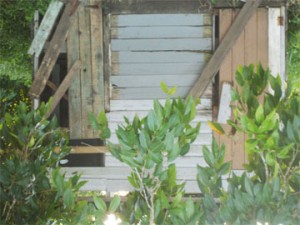The two major Amerindian organisations in Guyana have added their voices to the calls for pit latrines to be outlawed at all public schools regardless of where they are located following the tragic death of nine-year-old Tenesha De Souza last Monday when she fell into the latrine at her Santa Rosa, Moruca, school.
The Amerindian Peoples Association (APA) and the Guyanese Organisation of Indigenous Peoples (GOIP) yesterday called on the government to install flush toilets at all schools.
Fred Fredericks, an elder in GOIP, said it was “slackness” on the part of the government that an Amerindian child could die in such a manner, adding that the administration “doesn’t care for Amerindian people.”
David James of the APA said the policy of having pit latrines at schools should be reviewed as quickly as possible and flush toilets should be installed at all schools.
PNCR parliamentarian, Dr George Norton, who represents Amerindians in parliament for his party, yesterday echoed the sentiments expressed by the child’s parents, Robin and Vanessa De Souza, for flush toilets at the school.
Stabroek News attempted to get a comment from the Minister of Amerindian Affairs, Pauline Sukhai, but calls and a visit to her office proved futile as on all occasions her secretary said she was in a meeting.

Minister of Education, Shaik Baksh, when contacted last week following the death of the child had indicated that his ministry had no intention of phasing out pit latrines at schools as they were internationally accepted as a proper form of sanitation disposal.
James recalled that many years ago while he was a teacher at the Santa Rosa Secondary School teachers and parents of that school had lobbied for flush toilets to be installed and some were installed. “If you say you are going to build a modern school, why not build flush toilets for the school?” he asked. He noted that in the instance of the primary school, a new school was built but children were still being forced to use pit latrines. “It is a shame that flush toilets were not installed. This is not a case of money. Money should not be used as an excuse,” he said, adding that certainly following the death of the child the pit latrine system should be reviewed.
Norton said he knew of instances where school buildings were handed over to Amerindian villages with no toilets “not even pit latrines” and it was only after parents would have protested that they were built.

“The nature of things in this country means that if teachers and parents do not protest for something, nothing is done,” Norton said.
Fredericks said that from all appearances whenever appeals are made to the government for Amerindian people the appeals fall on deaf ears. He said the death of Tenesha De Souza was really “tragic” adding that pit latrines should be outmoded. “The government should do better than that. It is only at election time they would come around and campaign and if you ask, they may give you a toilet bowl. We should be treated better,” he said.
Meanwhile, the 56-year-old grandfather of the child, Marco De Souza, who was once a parliamentarian under this administration, said he had attended the same school as a child and it was sad that it still had pit latrines all these years later. He said the ministry also needed to understand that the environs of the school would now be unhealthy as the ground was “porous so to speak, since all they are doing for many years since I was a child is covering holes filled with faeces and digging more holes to build pit latrines.”
He questioned that in this “modern world why can’t flush toilets be built at one of the oldest schools in the hinterland.”
The school has flush toilets but they are for teachers while at the nursery school next door, flush toilets are provided for that school’s population.
“If they have flush toilets for the teachers why not for the children?” the child’s grandfather asked, adding that other schools in the hinterland had flush toilets. “We are not pleased about this situation and representatives from the ministry should come into the area,” the man suggested.
While Baksh has touted pit latrines as internationally accepted, the organization, WASTE, which is an adviser for development projects in countries in Africa, Asia, Latin America and Eastern Europe, recommends on its website that that form of faeces disposal should not be utilised.
“Pit latrines are rarely a good alternative, especially in places with high population density. Excreta, urine and water are mixed, the content from pit latrines can therefore seep easily into the underground water supply system,” the organisation said on its website. It said that the danger of leaking pit latrines is “even worse in times of rain, flooding and high groundwater level. This means contamination of the drinking water, spreading diseases and pollution of the school surroundings.”
The World Bank, on its website said pit latrines were the best conventional sanitation option “when there is no source of water on or close to the plot so that water use is low”. It listed a number of disadvantages to the use of this system.
The World Bank said pit latrines might smell, emptying the pits might be problematic; people might opt to dig a new pit and move the superstructure into a new location, if land were available. It said that high water table and/or flooding were obvious problems for pit latrines. However, it also pointed out that pit latrines were cheaper than other sanitation options.





